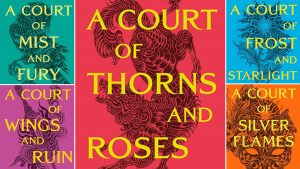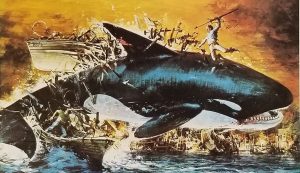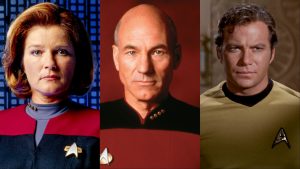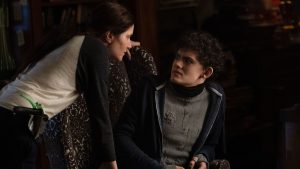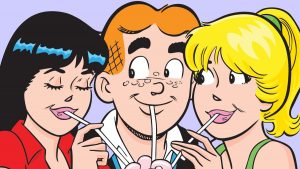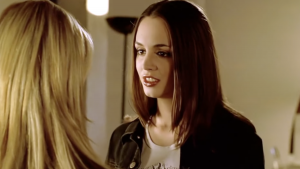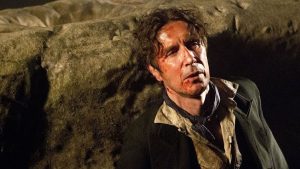
Film historians agree that computer-generated imagery (CGI) was first used in a motion picture as far back as Alfred Hitchcock’s Vertigo (1958), which utilized abstract computer animation under its opening credits. Of course that’s not immediately what comes to mind when we think of CGI (or just plain CG) today: the earliest, crude instances of the kind of CG that dominates modern filmmaking were first seen in Westworld (1973), Star Wars (aka A New Hope, 1977), Looker (1981), the groundbreaking Tron (1982), Star Trek II: The Wrath of Khan (1982), and The Last Starfighter (1984).
But the first genuine leap in using CG to animate and incorporate photorealistic three-dimensional objects into live-action came in James Cameron’s The Abyss (1989) via the creation of the alien pseudopod made out of digital ocean water. The techniques developed by Industrial Light and Magic for that film blew open the doors to the true CG revolution in cinema, which began in the 1990s and has been ongoing ever since.
It was in fact during the ‘90s that a film seemed to come along almost every year that pioneered the use of CG in some way and that moved the technology forward in massive leaps. It’s no overstatement to say that a number of films released during this decade helped change the movie industry for all time, for better or worse, as CG and digital visual effects began to overtake practical on-set effects, stop-motion animation, and other longstanding techniques that were quickly left in the dust. We all know CG’s shortcomings, of course, but even 2024 films like Kingdom of the Planet of the Apes continue to push the boundaries of what is imaginable. And the true transformation began just over three decades ago, with a series of films that permanently altered the landscape of filmmaking and what filmmakers could imagine—as well as what we expected out of a Hollywood “event.”
Terminator 2: Judgment Day (1991)
Building off what he and his teams had accomplished with the relatively brief pseudopod sequence in The Abyss, James Cameron (with the help of ILM, Pacific Data Images, and four or five other companies) ushered in the CG revolution with this groundbreaking sci-fi/action sequel. A 10-month post-production process, which went on right up until the film’s release, resulted in the creation of the first all-CG humanoid character, the T-1000.
It would take way more space than we have here to discuss how the T-1000 (and, frankly, a lot of the creations in this article) was developed, but the shapeshifting, liquid metal cyborg (played in “human” form by Robert Patrick) was designed to move like a human and seamlessly integrate into a live-action environment, right down to the android’s reflective surface and sense of weight and mass. The T-1000 was also a fully digital creation—which would become more prevalent as the decade went on. At the time audiences were absolutely astonished by the creation. As Bill Cosford wrote for the Miami Herald, “Amazing things happen in Terminator 2, things you’ve never seen in movies — things you didn’t know the movies could do.”
Jurassic Park (1993)
Before Jurassic Park came along, live-action dinosaurs on the screen were created through stop-motion animation, actors in costumes, or animatronic models—the former having been used in some way, shape, or form since the turn of the century. Steven Spielberg’s movie changed all that, as Industrial Light and Magic (yes, them again) created the first photorealistic CG animals, who, of course, just happened to be extinct for millions of years. In other words, there was no record of how they actually moved or sounded.
Nevertheless, ILM proved to Spielberg that CG-generated dinosaurs could work after initial efforts by stop-motion animator Phil Tippett were deemed ineffective (Tippett and his team remained to design animatics and consult on the movements). While Stan Winston did create full-sized animatronics as well, it’s the still awe-inspiring CG creatures that Jurassic Park will always be remembered for—the first modern realization of dinosaurs onscreen in a live-action film, making Jurassic Park a movie for the ages (and, until Titanic came along, the highest-grossing film of all time).
Reportedly, when Jurassic Park producer Kathleen Kennedy first saw an animated CG skeleton for a Tyrannosaur in the offices of ILM (which was in turn shown to her as an act of rebellion by animator Steve “Spaz” Williams), she simply stated, “You have a bright future.” So did digital characters, as the visuals of Jurassic Park were reimagined from the ground up.
Forrest Gump (1994)
Robert Zemeckis’ best picture Oscar winner also earned an Oscar for best visual effects, although Forrest Gump is more low-key in the sense that it does not feature rampaging dinosaurs or a shape-shifting liquid metal cyborg. But make no mistake, from the Vietnam War napalm sequences to Lieutenant Dan’s (Gary Sinise) missing legs to, most famously, the scenes of naïve Forrest (Tom Hanks) finding himself in the midst of historic moments alongside real (deceased) historical figures—it was all done with CG.
While it might seem quaint in a modern world of deep fakes and AI gags created by kids on TikTok, Forrest Gump astonished audiences in 1994 who struggled with understanding how Tom Hanks appeared to be interacting in historic footage with the likes of President Lyndon B. Johnson and John Lennon: baby boomer touchstones who’ve long since shuffled off this mortal coil. At the time of its release, L.A. Weekly‘s Kristal Brent Zook marveled, “Forrest Gump is for big kids what playing Nintendo is for little ones — that is, the neato thing about Robert Zemeckis’ film is the clever techno-wizardry produced by Ken Ralston and Industrial Light and Magic.”
Forrest Gump excelled at making CG less obtrusive. It did not depict science fiction creations, but things that could plausibly happen, with a heightened sense of realism. Zemeckis took this even further in Contact three years later, but this boundary-pushing filmmaker eventually went too far: later, all-CG films like The Polar Express, Beowulf, and A Christmas Carol pushed his characters into that weird “uncanny valley” territory at the expense of the story.
Babe (1995)
Talking animals were a staple of storytelling, both on film and TV, for years, but director/co-writer Chris Noonan and producer/co-writer George Miller’s Babe used the breakthroughs happening in CG to create the most realistic, and charming, talking animals seen onscreen to that point. While the movie’s beloved menagerie of farm animals were a mix of incredibly detailed animatronic puppets and real creatures, CG was used by the Rhythm & Hues VFX shop to create the illusion of the animals’ mouths moving to form words (never seen before), as well as realistically emotional facial expressions.
“It was a huge step forward as far as using visual effects for telling a story,” VFX supervisor Scott E. Anderson told IndieWire in 2020. “Instantly it started a different [performance-driven] trend.” And it was impressive enough to not just change the “talking animals” genre forever, but to beat out odds-on favorite Apollo 13 for that year’s Oscar for Best Visual Effects.
Toy Story (1995)
Toy Story changed the nature of animated films for all time. While hand-drawn, frame-by-frame animation is still a viable and beloved craft, the first official feature film from Pixar Animation Studios was also the first animated film created completely through CG—and as a result it’s not only one of the greatest animated movies of all time, but one of the most important in film history.
While the development and production of Toy Story was incredibly turbulent (due mainly to creative and cultural clashes between Pixar and Disney, which oversaw and distributed the film), the level of detail, depth, and vibrancy in the animation was unparalleled up at that point. Tom Schumacher, then vice president of Walt Disney Feature Animation, told Deseret News, “We couldn’t have made this movie in traditional animation.” Prophetic words indeed, as Pixar began a reign as the top animation studio in Hollywood that lasted for the next quarter century. Family audiences had never seen anything like it. Soon enough, however, almost all Hollywood animation would seek to imitate the three-dimensional worlds of Andy’s playroom.
Twister (1996)
Two films came out in 1996 and, thanks to the use of CG, revived two rather moribund genres: the disaster movie and the alien invasion epic. The first of these was Jan de Bont’s Twister, which brought extreme weather to the screen with a realism and ferocity that hadn’t been seen up to that point (although we still think the tornado in The Wizard of Oz looks pretty damn good for 1939).
According to the The Ringer, ILM creator Habib Zargarpour used particle system software to generate literally millions of tiny CG “particles” that made up the funnel clouds that were the real stars of Twister. ILM shot a proof-of-concept sequence that producers Steven Spielberg and Kathleen Kennedy shopped to Hollywood, with two studios, Warner Bros. for international and Universal for domestic, instantly signing on despite there not being even a script. CG was also used to create the objects—trucks, telephone poles, trees, and, of course, a cow—that were hurled into the air by the twisters’ destructive force. The result was, at that time, the most realistic and frightening depiction of a tornado ever seen onscreen.
Independence Day (1996)
Just two months after Twister brought the disaster movie back to life, Roland Emmerich’s Independence Day said “hold my beer,” proceeding to fuse that genre with a super-sized version of the well-worn alien invasion trope. Not only did the movie present the latter on a scale never seen before—with massive alien ships hovering over cities or releasing dozens of smaller craft for intense dogfights with human jet fighters—but it also gave us the resultant destruction in far more colossal and visceral terms.
More than 3,000 special effects shots were ultimately required for the film, although Emmerich and producer Dean Devlin actually tried to use practical VFX more than CG whenever possible. The famous shot of the White House being destroyed, for example, was done through the use of a model, as were scenes of other landmarks being razed. But plenty of CG was utilized for the film as well, particularly for the battle sequences. In one fell swoop, Independence Day (with the assist from Twister) resurrected two beloved genres and paved the way for films like Dante’s Peak, Armageddon, Deep Impact, and others. It thus became a selling point by the mid-’90s if a movie had CG effects, making old formulas seem new and vivid.
Starship Troopers (1997)
Initially derided by critics and a failure at the box office, Paul Verhoeven’s Starship Troopers is now considered a cult classic and an ahead-of-its-time satire of how a society can slide into fascism to preserve itself against an outside threat—in this case, horrific alien invaders known as “arachnids” (or “bugs”) who overrun every human outpost in space, ruthlessly and gruesomely.
While acclaimed for the way it subverts the militarism and totalitarian aspects of the source novel by Robert A. Heinlein, Starship Troopers has been overlooked in some ways for its often astounding (especially for 1997) visual effects. Half the film’s $100 million budget went to create its 500 VFX shots, which were created by ILM, Phil Tippett Studio, and Sony Pictures Imageworks (Sony Pictures execs did not realize that they were watching CG when shown a test footage reel before greenlighting the movie). Starship Troopers featured the first hand-to-hand (or hand-to-claw) military battles between humans and aliens on a massive scale, something that could not have been accomplished even 10 years earlier.
Titanic (1997)
Just two years after Independence Day and Twister brought disaster movies back to the forefront, one not only became the highest-grossing movie of all time but won 11 Oscars out of 14 nominations, including Best Picture and Best Director for James Cameron. Titanic was also the most expensive movie ever made up to that point ($200 million), with ILM and Cameron’s own Digital Domain shop creating ships, rushing water, and ocean vistas wholly out of CGI (although ship miniatures were also used).
Titanic also pushed the envelope for the digital creation of crowds, populating the deck of the doomed ocean liner with hundreds of human simulations for both its earlier scenes and the chaotic sequences of the vessel sinking. Digital people were also used for some of the more horrific and dangerous shots of passengers falling as the ship upended itself before sliding into the water. The advancements set in motion by the crowd work on Titanic can be seen right up to the present in films like Dune and Gladiator II.
The Matrix (1999)
Incredibly, Lana and Lilly Wachowski’s The Matrix marked the first time that a man named John Gaeta worked as a solo VFX supervisor on a movie (he had toiled previously as an assistant on various other projects). To create the virtual, enhanced world of the story, Gaeta and associates essentially came up with the concept of “virtual cinematography,” in which nearly every element of the sequence is either captured or created digitally (yes, we’re simplifying quite a bit here, so forgive us).
All the innovations used in the film, including photorealistic digital backdrops and the erasure of cameras from 360-degree shots, provided the basis for the movie’s crowning achievement, the “bullet time” sequence. The pioneering work done on The Matrix not only proved massively influential on the next 25 years of VFX and science fiction filmmaking, but helped the novice Gaeta beat out a true behemoth for the Best Visual Effects Oscar…
Star Wars: Episode I – The Phantom Menace (1999)
That behemoth was Star Wars: Episode I – The Phantom Menace, an event film George Lucas finally began working on in the early 1990s after he determined that CG had progressed enough for him to return to the Skywalker Saga. And he returned in massive style, far eclipsing the then-pioneering work on the original trilogy: The Phantom Menace was a VFX spectacle like none ever before attempted, reportedly utilizing more than 2,000 VFX shots—at least 500 more than most blockbusters—and integrating some kind of digital element into 95 percent of not only the movie’s scenes, but individual frames.
Among The Phantom Menace’s achievements were the creation of the first all-CG major character (unfortunately that character was Jar Jar Binks), as well as 65 others, along with new software to make their clothing as realistic as possible. The pod race alone took a year just to research while the entire post-production process ate up nearly two years. The result, however, was a film that deployed more VFX created through digital means than anything previously produced, which changed the nature of how movies would be made going forward. Whatever you may think of what followed—either in the Star Wars universe or filmmaking itself—we can do what us geeks do best: blame George Lucas.
The post The ’90s CGI Movies That Changed How We Looked at Film appeared first on Den of Geek.
